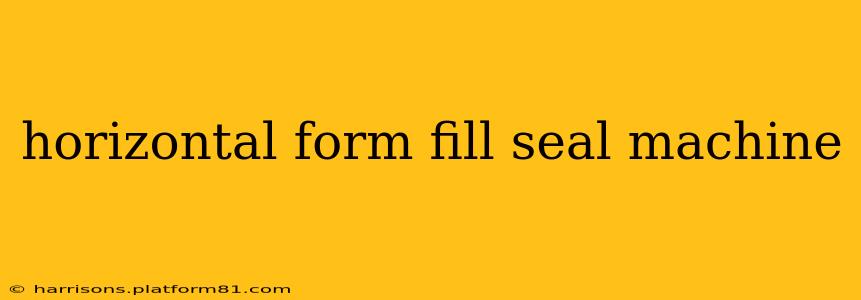Horizontal Form Fill Seal (HFFS) machines, also known as horizontal flow wrappers, are high-speed packaging solutions used across various industries to efficiently package a wide range of products. This comprehensive guide delves into the intricacies of HFFS machines, addressing common questions and offering valuable insights for anyone considering this packaging technology.
What is a Horizontal Form Fill Seal Machine?
A horizontal form fill seal machine is a sophisticated piece of automated packaging equipment that creates three-sided or four-sided sealed pouches from a continuous roll of flexible packaging material. The process involves forming a tube from the film, filling it with the product, and then sealing it to create individual packages. This contrasts with vertical form fill seal machines, which create bags from the bottom up. HFFS machines are favored for their speed, efficiency, and ability to handle a diverse range of products and package sizes. They are commonly used for packaging items like snacks, frozen foods, pet food, and pharmaceuticals.
What are the Different Types of HFFS Machines?
Several types of HFFS machines exist, categorized based on their design and capabilities:
- Intermittent Motion Machines: These machines operate in a stop-and-go cycle, ideal for slower production speeds and larger, heavier products. They offer precise control and are often chosen for applications requiring high accuracy.
- Continuous Motion Machines: These machines operate at high speeds, continuously forming, filling, and sealing pouches. They are best suited for high-volume production of smaller, lighter products.
- Rotary Machines: Rotary HFFS machines are a type of continuous motion machine offering exceptionally high speeds and efficiency, making them perfect for large-scale operations.
The specific type of machine required depends on factors like production volume, product characteristics, and desired packaging format.
How Does a Horizontal Form Fill Seal Machine Work?
The operation of an HFFS machine involves several key steps:
- Unwinding: The flexible packaging material (film) unwinds from a roll.
- Forming: The film is formed into a tube, usually through a series of rollers and shaping devices.
- Filling: The product is precisely measured and dispensed into the formed tube. This can involve various filling methods, such as volumetric fillers, weigh fillers, or liquid fillers, depending on the product’s nature.
- Sealing: The filled tube is sealed on three or four sides, creating individual pouches. This typically involves heat sealing or ultrasonic sealing.
- Cutting: The sealed pouches are cut and separated from the continuous web.
- Output: The finished packages are conveyed to the next stage of the packaging process, often involving collection and boxing.
What are the Advantages of Using an HFFS Machine?
HFFS machines offer numerous advantages:
- High Speed and Efficiency: They can produce thousands of packages per hour.
- Versatility: They can handle a wide range of products and packaging materials.
- Cost-Effective: Despite the initial investment, the high throughput makes them cost-effective in the long run.
- Reduced Labor Costs: Automation significantly minimizes manual labor requirements.
- Improved Product Protection: Sealed pouches provide excellent protection against contamination and environmental factors.
What are the Disadvantages of Using an HFFS Machine?
While offering many benefits, HFFS machines also have some drawbacks:
- High Initial Investment: The purchase and installation cost can be significant.
- Maintenance Requirements: Regular maintenance is crucial to ensure optimal performance.
- Complexity: Operating and maintaining the machine requires trained personnel.
- Space Requirements: They require substantial floor space for installation and operation.
What are the Different Types of Packaging Materials Used with HFFS Machines?
HFFS machines can utilize various flexible packaging materials, including:
- Polyethylene (PE): A common choice for its flexibility, durability, and cost-effectiveness.
- Polypropylene (PP): Offers superior heat resistance and clarity compared to PE.
- Laminates: Combining different materials to achieve specific properties like barrier protection against oxygen or moisture. Examples include PE/PP laminates or foil laminates.
What are the Applications of Horizontal Form Fill Seal Machines?
HFFS machines are widely used across diverse industries, including:
- Food and Beverage: Packaging snacks, confectionery, frozen foods, and more.
- Pharmaceuticals: Packaging tablets, capsules, and powders.
- Cosmetics: Packaging creams, lotions, and powders.
- Industrial Goods: Packaging small parts and components.
How Much Does a Horizontal Form Fill Seal Machine Cost?
The cost of an HFFS machine varies significantly depending on factors such as size, speed, features, and manufacturer. Prices can range from tens of thousands to hundreds of thousands of dollars. A thorough cost-benefit analysis is crucial before making a purchase.
This guide provides a comprehensive overview of horizontal form fill seal machines. For specific applications or machine selection, consulting with packaging equipment specialists is highly recommended.
